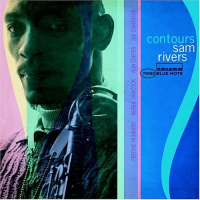Home » Jazz Articles » Album Review » Sam Rivers: Contours
Sam Rivers: Contours
And it's a shame, because along with Hill and others, including another sadly-overlooked artist, trombonist Grachan Moncur III, Rivers was at the forefront of the mid-'60s movement that evolved hard bop towards a more left-leaning avant-garde. And while Rivers recorded fewer albums as a leader for Blue Note than Hill, his contributions are equally significant, just in a different way. While Hill leaned towards complex, convoluted compositions that set the stage for more oblique improvisations, Rivers, while no less cerebral, was a looser spirit, more disposed towards a liberated approach that combined heady themes with enough swing to satisfy the hard bop enthusiast, and exploratory soloing that took it all to a different place for the more enthusiastic experimentalist. None of Rivers' Blue Note releases combined these elements more successfully than '65's Contours , finally reissued in remastered form with an alternate take of the aptly-titled "Mellifluous Cacophony" included as a bonus.
Joining Rivers on the date are trumpeter Freddie Hubbard, drummer Joe Chambers and, most significantly, pianist Herbie Hancock and bassist Ron Carter, two players who were also exploring a more intellectual avenue between tradition and invention with Miles Davis, albeit with a more elastic time sense thanks to drummer Tony Williams. Chambers, who emerged seemingly out of nowhere around '64, was no less investigative than Williams but, on sessions with artists including Bobby Hutcherson, Wayne Shorter and Hill, demonstrated a lighter touch, less of the explosive power that was Williams' inclination. Whereas Hancock, Carter and Chambers had proven themselves with more outer-reaching material, the surprise of the set is Hubbard, a player who typically leaned more towards the hard bop centre, but on this set is positively on fire, matching Rivers note-for-note on "Dance of the Tripedal," a more-or-less swinging ¾ time piece that is anchored by Chambers until Hancock's abstract solo breaks down the time and Chambers confidently reasserts it.
Rivers' tenor is sharp and incisive as always, but it's his reedy, oboe-like soprano that sets the pace on "Point of Many Returns," a piece with a challenging but memorable theme. Chambers and Carter swing hard through Hubbard and Hancock's spots but become more adventurous with time during Rivers' visceral but clearly considered solo. And on the more transcendent "Euterpe" Rivers' flute combines with Hubbard's muted horn to create an attractive texture.
Rivers would ultimately go on to further heights of freedom, but with Contours he posits a formal yet less rigid compositional alternative to Hill's more intricate constructions that is essential listening.
Track Listing
Point of Many Returns; Dance of the Tripedal; Euterpe; Mellifluous Cacophony; Mellifluous Cacophony (alt tk)
Personnel
Sam Rivers
saxophone, tenorFreddie Hubbard (trumpet), Sam Rivers (tenor and soprano sax, flute), Herbie Hancock (piano), Ron Carter (bass), Joe Chambers (drums)
Album information
Title: Contours | Year Released: 2004 | Record Label: Blue Note Records
< Previous
Ten
Next >
Live At Athenaeum Jazz
Comments
Tags
For the Love of Jazz
 All About Jazz has been a pillar of jazz since 1995, championing it as an art form and, more importantly, supporting the musicians who create it. Our enduring commitment has made "AAJ" one of the most culturally important websites of its kind, read by hundreds of thousands of fans, musicians and industry figures every month.
All About Jazz has been a pillar of jazz since 1995, championing it as an art form and, more importantly, supporting the musicians who create it. Our enduring commitment has made "AAJ" one of the most culturally important websites of its kind, read by hundreds of thousands of fans, musicians and industry figures every month.




















